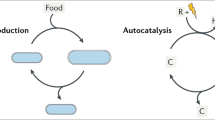Abstract
It is shown that biological-natural-selection-like behavior can occur, as a general type of time evolution, in a statistical system where detailed balance is violated owing to the presence of metastable energy states. A model of a non-equilibrium phase transition corresponding to the spontaneous origin of self-reproduction in the system is suggested. After a phase transition, the system passes from one quasistationary distribution of self-reproducing subsystems to another, with an increase in the total organization, as long as the growth of the energy flow through the system or a reduction of energy dissipation in the system is possible. The entropy production is calculated for this process in terms of “selective values” of Eigen's theory for self-organization in autocatalytic systems. Correspondence of the extremal principle of Eigen's theory with the criterion of evolution in Prigogine's thermodynamics is established.
Similar content being viewed by others
References
P. Glansdorff and I. Prigogine,Thermodynamic Theory of Structure, Stability and Fluctuations (Wiley, New York, 1971).
G. Nicolis and I. Prigogine,Self-Organization in Nonequilibrium Systems (Wiley, New York, 1977).
H. Haken,Synergetics (Springer, Berlin, 1978).
J. E. Marsden and M. McCracken,The Hopf Bifurcation and Its Application (Springer, New York, 1976).
I. Prigogine,Etude Thermodynamique des Phénomènes Irreversibles (Desoer, Liège, 1947).
M. Eigen,Naturwiss. 53:465 (1971).
M. Eigen and P. Shuster,The Hypercycle (Springer, Berlin, 1979).
C. J. Thompson and J. L. McBride,Math. Biosci. 21:127 (1974).
B. L. Jones, R. H. Enns, and S. S. Rangnekar,Bull. Math. Biol. 38:15 (1976).
B. S. Hartleyet al., Where Do New Enzymes Come From? InEnzymes: Structure and Function, Vol. 29 (North-Holland, Amsterdam, 1972).
D. W. Tempest,Trends Biochem. Sci. 3:112 (1978).
L. Peusner,Concepts in Bioenergetics (Prentice-Hall, Englewood Cliffs, New Jersey, 1974).
F. R. Gantmacher,The Theory of Matrices (Chelsea, New York, 1960).
L. D. Landau and E. M. Lifshitz,Statistical Physics, 2nd ed. (Pergamon, New York, 1968).
C. P. Swanson and P. L. Webster,The Cell (Prentice-Hall, Englewood Cliffs, New Jersey, 1977).
Author information
Authors and Affiliations
Rights and permissions
About this article
Cite this article
Chudnovsky, E.M. Thermodynamics of natural selection. J Stat Phys 41, 877–897 (1985). https://doi.org/10.1007/BF01010008
Received:
Issue Date:
DOI: https://doi.org/10.1007/BF01010008



